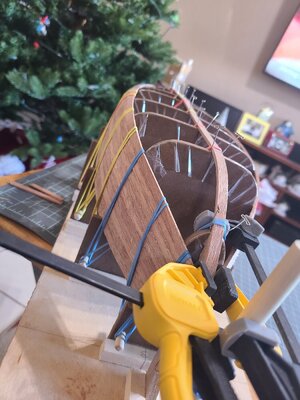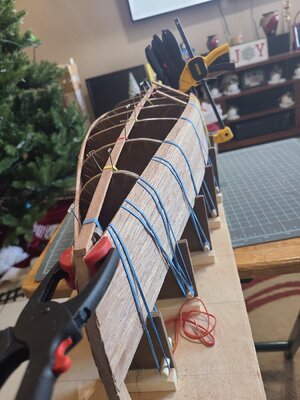-

Win a Free Custom Engraved Brass Coin!!!
As a way to introduce our brass coins to the community, we will raffle off a free coin during the month of August. Follow link ABOVE for instructions for entering.
-

PRE-ORDER SHIPS IN SCALE TODAY!
The beloved Ships in Scale Magazine is back and charting a new course for 2026!
Discover new skills, new techniques, and new inspirations in every issue.
NOTE THAT OUR FIRST ISSUE WILL BE JAN/FEB 2026
You are using an out of date browser. It may not display this or other websites correctly.
You should upgrade or use an alternative browser.
You should upgrade or use an alternative browser.
Yes I have been sanding the edges on the planks prior to installing them, thank you for pointing this out.You may have been anticipating and filing the edges for the planks around the transition radius from side to bottom so that each one has a properly angled face to receive, tightly, the plank being added. This was not as critical coming down the sides were the edges were at right angles. Your log is helping me in considering my drafting of the bulkheads to mold my trade ship hull. I have decided to not include frames with these bulkheads but form and insert them after the keel/hull are completed. Thanks for providing your log. Rich
The way you describe, adding the frames after the hull shell is completed, is how this boat is built.
Creating and maintaining this log has been my pleasure! I certainly appreciate everyone's participation in it-without it I'd feel like I was talking to myself.
Glenn
Nice and tightly laid planking strakes! RichProgress is slow but steady. Here you can see the bends and twists the current strakes make. These photos are of the starboard side.
From Stern
View attachment 280729
From Bow

Glenn
Thank you Rich!
Nice and tightly laid planking strakes! Rich
All of a sudden I’m not excited about starting this build. All the twists and turns of the wood! I think there’s a soap opera named for this boat: “As the Wood Turns.“
Kurt Konrath
Kurt Konrath
Ha Ha, that is funny, I am old enough to remember the old soaps, not that I watched it.All of a sudden I’m not excited about starting this build. All the twists and turns of the wood! I think there’s a soap opera named for this boat: “As the Wood Turns.“
But this teaches you how to deal with issues when you get your build going.
Yes, there is lots of twist, turns, individuality of beveling and tapering of the topmost planks on the hull and prebending the planks to match the geometry of the hull before gluing because some planks goes from vertical on the stern to horizontal as the planks approaches the bow.
Very and most uncomfortable process.
Very and most uncomfortable process.
I’m still a little unsure of the plank beveling process. Do you sand the inboard corner of the strake? If so, how much?Yes, there is lots of twist, turns, individuality of beveling and tapering of the topmost planks on the hull and prebending the planks to match the geometry of the hull before gluing because some planks goes from vertical on the stern to horizontal as the planks approaches the bow.
Very and most uncomfortable process.
I prebend them dry by hand up to the point that will not brake and by looking from the top I calculate how much and where should I bevel and mark it with a pencil where to start and mark where should I stop.
Dry fitting little by little until I am comfortable.
By the way, I use a small block with sandpaper to do the beveling.
Tedious job but think only about how good is going to look not how much you are sweating.
Dry fitting little by little until I am comfortable.
By the way, I use a small block with sandpaper to do the beveling.
Tedious job but think only about how good is going to look not how much you are sweating.
Scott, the manufacturer of this boat kit, describes two methods of beveling the planks. One is as @Bluebeard already described. The other uses the method of marking like Bluebeard described, except the marking is done on the plank already glued in place. The bevel is then worked by carefully carving with a sharp edge such as a scalpel or Xacto knife.
I tried the knife as Scott explained in the instruction book and it didn’t go well at least with me. I cut too much. It is a bit harder to control the knife while with the sanding block w/80 grit, you have total control not to go over what you need.
Still looking great.Progress is slow but steady. Here you can see the bends and twists the current strakes make. These photos are of the starboard side.
From Stern
View attachment 280729
From Bow

Glenn
For shaping the edges of each plank take it a little bit at a time with multiple tests to see how the faces meet and adjust accordingly. Patience wins the game. Visualize what angle the lower/set plank has for that face and then the lower edge of the next plank above to have the angles correspond. After you do a few it will be more obvious what is needed. Onlce around the bilge you are back to almost a flat bottom which will be similar to the upper hull sides. RichI’m still a little unsure of the plank beveling process. Do you sand the inboard corner of the strake? If so, how much?
- Joined
- Jan 9, 2020
- Messages
- 10,548
- Points
- 938

@GAStan Hi Glenn. Are you talking about beveling or tapering the plank? You mention there are two types of beveling - one is cutting the plank with a scalpel. That to me sounds like tapering. Beveling a plank is done is when you sand an angle on the edge of the plank to make sure it fits seamlessly against the previous one. I'm confused.
Good Morning Glenn. Awesome job, tapering, beveling and twisting thus far. I personally would go Bluebeards method, takes the risk out of those blade slips...I made those on way simpler tasks. Which ever way you are going you are achieving an awesome result. Cheers.I tried the knife as Scott explained in the instruction book and it didn’t go well at least with me. I cut too much. It is a bit harder to control the knife while with the sanding block w/80 grit, you have total control not to go over what you need.
Beveling. Picture the edge of the last plank glued in place with it's square edge ready to receive the next plank. That's the edge that is beveled with the scalpel instead of the one that will be glued in next.@GAStan Hi Glenn. Are you talking about beveling or tapering the plank? You mention there are two types of beveling - one is cutting the plank with a scalpel. That to me sounds like tapering. Beveling a plank is done is when you sand an angle on the edge of the plank to make sure it fits seamlessly against the previous one. I'm confused.
- Joined
- Jan 9, 2020
- Messages
- 10,548
- Points
- 938

Gotcha - thank you for the clarification Glenn!Beveling. Picture the edge of the last plank glued in place with it's square edge ready to receive the next plank. That's the edge that is beveled with the scalpel instead of the one that will be glued in next.






